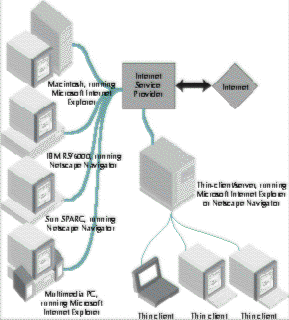
| Internet | Intranet | Extranet | |
| Access | Public | Private | Semiprivate |
| Who are the users? | Anyone | Limited to members of a single organization or company | Group of companies joined together in an alliance |
| What type of information? | All types of data | Proprietary and/or confidential data specific to the company | Proprietary and/or confidential data for only those in a specific relationship |
| Examples of use | Getting stock quotes, headline news, or distributing general information | Getting internal job openings at the company, a technical white paper for support, status information, or group or departmental information | Supply-chain management |
The Internet These days, the terms “Internet” and “World Wide Web” refer to the same entity. CERN, the European Particle Physics Laboratory, proposed the World Wide Web (WWW) project in 1989 and developed the first prototype in 1990. Its purpose was to share papers and data with physicists all over the world. The WWW project was intended to share information across computer networks as simply as possible. Before the WWW and the use of HTML with a browser, users would access information with text-based tools.
Since 1990, Web servers have evolved from their original purpose of sharing scholarly research to disseminating all kinds of information—from marketing brochures to interactive applications. For many companies, these applications are becoming mission-critical components for conducting business. The Web allows companies to take advantage of this low-cost, low-maintenance means of deploying applications across low-bandwidth and high-bandwidth connections. In addition, organizations’ IS departments use the Internet to provide mobile users and those working from their homes with access to e-mail, support material and information, and even corporate data. Some of these users even access their particular company’s production network via an ISP, although this presents an additional layer of complexity due to the necessary security.
Big business is not the only entity benefiting from this low-cost means of deploying applications across the country and around the world. For example, in southwest Texas, several small regional libraries have banded together through the Internet to provide people in small towns with online access to all the resources available at major metropolitan libraries.
Web models aren’t just for business.
All of this is possible because of HTML—the standard, platform-independent language used to lay out and format Web pages. The Web server transmits these HTML files on demand over the Internet to a client machine running a Web browser (such as Microsoft Internet Explorer or Netscape Navigator), which displays the data or text according to the formatting commands
Because HTML is a standard language, pages written in HTML theoretically can be viewed by any browser, making the Web the perfect cross-platform vehicle for disseminating information and applications. (See Figure 2-5.)
Let’s keep a consistent standard.
In support of Web-based computing and HTML, Sun Microsystems created the Java language to work with Internet browsers and utilize the download-and-run method of application deployment from Web pages. I’ll discuss this in detail later.
FIGURE 2-5
The Internet is used on all types of computer systems and configurations.
